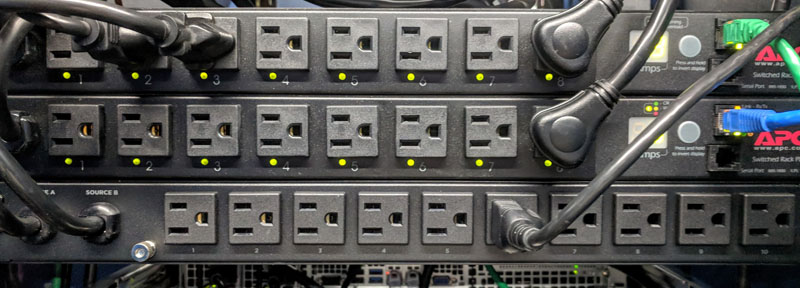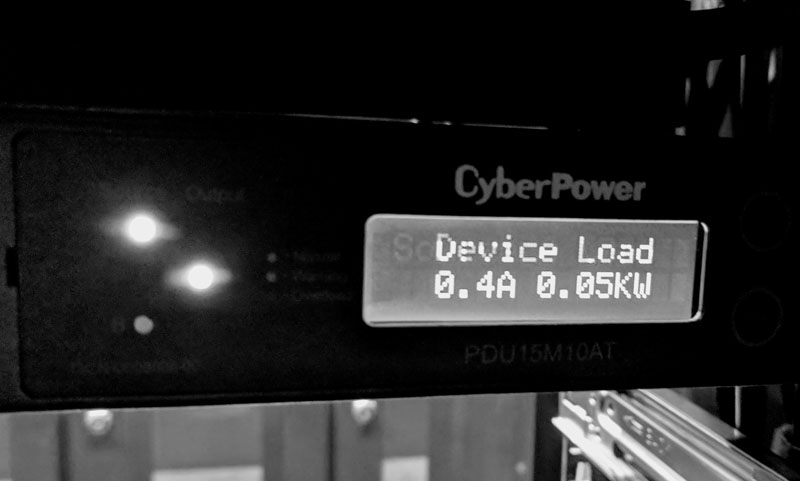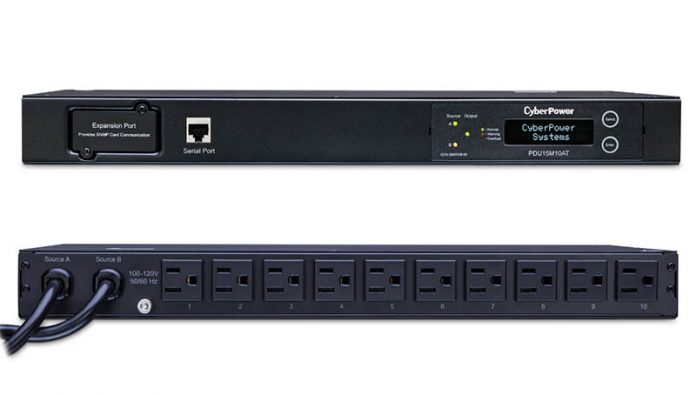Our CyberPower PDU15M10AT automatic transfer switching (ATS) PDU review will show what this solution is, and why you may need one. At STH, we test a ton of embedded products and others that have single power supplies. One of the biggest questions we get is around how to turn a single PSU device into something that can receive power from multiple sources. That can be A+B power in a datacenter or utility feed plus a battery backup on site. With one power input, many servers and appliances simply cannot handle two power feeds. In our recent piece, Explaining the Automatic Transfer Switching ATS PDU we show how an automatic transfer switching (ATS) unit can achieve that goal.
CyberPower PDU15M10AT ATS PDU Overview
The CyberPower PDU15M10AT ATS PDU is a 1U short-depth unit. You can easily mount it into 19″ two post racks. The business end has ten output 10 NEMA 5-15R ports. Inputs are two NEMA 5-15P ports so they will work in a variety of North American outlets.
CyberPower PDU15M10AT ATS FrontPower rating on the unit is for 15A or 12A de-rated on 100V-120V inputs. For our readers, do not be “that guy” and try plugging in 120V gear into 208V+ racks. If you have higher power racks, this is not the unit you want to use.
The flip side of the chassis has a LCD status display, LED indicators, and a serial console port.

Like many PDUs, these are relatively simple devices to explain. The magic of ATS PDUs happens when they deal with power failures on one of the power inputs.
CyberPower PDU15M10AT ATS PDU Hands-on Test
To test the unit, we had to create a setup where we could trip A + B power easily, so we hooked the CyberPower PDU15M10AT up to two remotely switched PDUs. As one would expect, the failover happened without any issue. An item worth mentioning is that the two power input cables are fixed and utilize 10 foot long cables. In our test configuration, this meant we had over 8 feet of extra cable, and that is only because we were using the far ports on the switched PDUs.

The LCD screen had a number of nice data points including power loading. It was also the primary method to set things like bias between power inputs. Since our test unit lacked remote management, the two options for setting this were to either use the serial port, or to manually poke at this LCD. If one is using a rack, even 30 inches deep, getting to this LCD screen and its buttons may be challenging, especially if you are exposing the power ports to the outside of the rack like we do.

Remote management is provided by the CyberPower PDU15M10AT. We did not have this unit for review.
Frankly, it is disappointing that this is an option. The cost of adding remote sensor data to devices has dropped by an enormous amount in the past few years. Virtually all servers, storage, and networking gear have out-of-band management built-in and many PDUs are following suit. The PDU15M10AT as an option that costs between $150-200 it is too much for what should be a basic capability. The unit already has a controller to output to the LCD display, so adding a HTTPS/ SMTP server should be a relatively nominal marginal cost.
Final Words
There are a few ways to look at the CyberPower PDU15M10AT. The core functionality of the unit is excellent. We tripped A and B power over 500 times, significantly more than one would expect when deployed, and did not have an issue with the fail over. Having ten output ports means that one can take ten single PSU devices and feed them A + B power which is a great benefit.
There are a few easy items around the edges where this could be improved. Swapping the fixed 10 foot input cables for IEC-320 C13 inputs with a locking mechanism to keep the cables in place would have been a killer design and fixed our deployment challenge of having more than 16 feet of extra power cable in our racks. We understand why CyberPower chooses to use fixed power cables and their choice was completely valid. At this point, adding remote management capabilities as standard functionality we would have liked to have seen. That fixes challenges of accessing the LCD screen and buttons locally and means one does not need a serial console cable. Network switches now have out of band management, servers almost all have out of band management, power needs to follow suit so using serial console devices for remote access is a leading practice from decades past.
For those that have devices that need A + B power, this unit worked as advertised which is about all one can ask for in an ATS PDU. Pricing wise, we purchased our unit off of Amazon at a price not much more than a standard 1U 10-port metered PDU which we thought was very reasonable.





All great till the one PSU fails. Seems like a niche product. I’d rather buy dual PSU servers to start. In cases where that isn’t possible, run two, one on A and one on B
Also, you mentioned the remote management unit’s part number as the units part number. it should be RMCARD202 or RMCARD203. One thing not mentioned, is whether this load balances power across both supplies, or if it’s only Active/Passive. If both inputs are hooked up and supplying power, do you see 50% lload on each input?
I didn’t even know something like this existed. Great ATS article linked above too
It will be active/passive as it is only a transfer switch. To be active / active it would either need to be a full time ups with dual power (one that converts all incoming power to DC then runs all equipment 24X7 off the inverter) or a powersupply that is directly connected 24×7 to a inverter. The reason for this is the need for true isolation between the a/c power legs. Without going to DC there us no way to stop the a/c from affecting the other leg in a balance scenario.
I just installed the PDU15M10AT. I tried testing the failover by unplugging the the A source. From the front, the LEDs showed power transferred to B… however, the power to all outlets turned off. I guess I got a defective unit?
That should not happen Curtis and is not how ours behaves.
Hello, could you help me by indicating where I can get it available since I could not find it, 2 units of: CYBERPOWER METERED ATS PDU 120V 30A 2 – PDU30MT17AT
and 2 units of:
CyberPower PDU15M10AT Metered ATS PDU 120V 15A 1U 10-Outlets